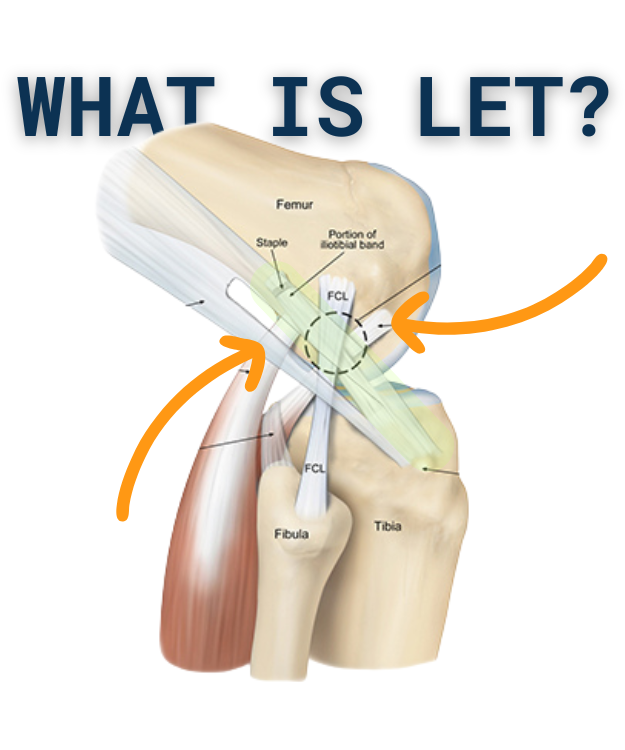What Is Lateral Extra-Articular Tenodesis (LET) — and Why Is It Performed With ACL Surgery?
Diagram of a Lateral Extra Articular Tenodesis
If you’ve been told you’re getting an ACL reconstruction with something called a Lateral Extra-Articular Tenodesis (LET), you might be wondering: What exactly is this procedure — and why do I need it?
LET isn’t a new technique, but it’s making a comeback in modern sports surgery. It’s increasingly used alongside ACL reconstruction to help improve knee stability, especially in high-risk athletes.
Let’s break down what LET is, how it works, and when it might be used.
What Is a Lateral Extra-Articular Tenodesis?
LET is a surgical technique performed on the outside (lateral side) of the knee to add extra rotational stability. It’s not a replacement for an ACL reconstruction — it’s an additional procedure, performed at the same time, to support the reconstructed ACL.
During LET, a strip of connective tissue (often from the iliotibial band or ITB) is re-routed and fixed to the femur. This helps limit internal rotation and pivoting motion of the knee — movements that are strongly linked to ACL injury and re-injury.
Why Add LET to ACL Reconstruction?
While ACL surgery alone restores much of the knee’s stability, some athletes — especially younger or high-performance individuals — are still at risk for instability or re-tear, particularly with pivoting, cutting, or rapid deceleration.
LET is typically considered when:
The athlete is under 25 years old
The sport involves pivoting, cutting, or jumping
There’s been a previous ACL reconstruction (revision)
There’s generalized ligamentous laxity or hypermobility
The athlete has a high-grade pivot shift seen in clinical testing
In these cases, adding LET helps to offload the ACL graft, reduce strain during rotational movements, and lower the risk of graft failure.
How Does LET Affect Rehab and Return to Sport?
The good news? Rehab following ACL + LET isn’t drastically different — but it does require a few specific considerations, especially early on.
Rehab implications may include:
Slightly more soft tissue soreness around the lateral knee
Potential extra tightness or stiffness in the early weeks
Close monitoring of rotational movement restoration
A slightly more conservative return to high-speed pivoting motions
At Project ACL, we tailor your rehab based on the exact surgical procedure you’ve had. That means if you’ve had an LET added, we’ll adjust your early mobility work, strength progression, and return-to-pivot training to protect the healing tissues while still moving you forward.
Does LET Really Work?
Research shows promising results:
Lower re-injury rates in high-risk athletes
Improved rotational control of the knee
Reduced risk of graft stretching or laxity over time
However, like any procedure, it comes with trade-offs. Some studies report a slightly higher risk of stiffness or outer knee discomfort — but in the right athletes, the benefits outweigh the risks.
In Summary: What You Need to Know
LET is a supportive procedure, added to ACL reconstruction to improve knee stability during cutting and pivoting
It’s often used in younger, high-risk, or revision cases
It reduces rotational strain on the ACL graft and may help prevent re-injury
Rehab will be customized to reflect the added procedure
Communication between surgeon, physiotherapist, and athlete is key
Had an LET with your ACL surgery?
We’ll make sure your recovery reflects that. Book your initial consultation with Project ACL to begin a rehab plan that’s built for your surgery — and your sport.

